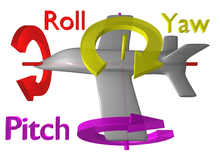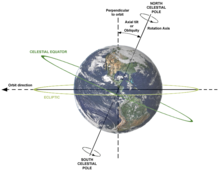Rotation: Difference between revisions
SylvieHorse (talk | contribs) mNo edit summary |
SylvieHorse (talk | contribs) mNo edit summary |
||
| Line 115: | Line 115: | ||
[[uk:Обертання]] |
[[uk:Обертання]] |
||
[[zh:自转]] |
[[zh:自转]] |
||
Source: #1 Wiki Answers and many more free online sources |
|||
Revision as of 02:21, 17 September 2009
Basic Deff.: The movement of one or more objects around another -Credit 6th Grade teacher Mr. Knox. Colorado Springs, Colorado

A rotation is a movement of an object in a circular motion. A two-dimensional object rotates around a center (or point) of rotation. A three-dimensional object rotates around a line called an axis. If the axis of rotation is within the body, the body is said to rotate upon itself, or spin—which implies relative speed and perhaps free-movement with angular momentum. A circular motion about an external point, e.g. the Earth about the Sun, is called an orbit or more properly an orbital revolution.
Mathematics

Mathematically, a rotation is a rigid body movement which, unlike a translation, keeps a point fixed. This definition applies to rotations within both two and three dimensions (in a plane and in space, respectively.) A rotation in three-dimensional space keeps an entire line fixed, i.e. a rotation in three-dimensional space is a rotation around an axis. This follows from Euler's rotation theorem.
All rigid body movements are rotations, translations, or combinations of the two.

A Rotation is simply a progressive radial orientation to a common point. That common point lies within the axis of that motion. The axis is 90 degrees perpendicular to the plane of the motion. If the axis of the rotation lay external of the body in question then the body is said to Orbit. There is no fundamental difference between a “rotation” and a “orbit” and or "spin". The key distinction is simply where the axis of the rotation lay, either within or without a body in question. This distinction is and can be demonstrated in and for both “ridged” and “non ridged” bodies.
If a rotation around a point or axis is followed by a second rotation around the same point/axis, a third rotation results. The reverse (inverse) of a rotation is also a rotation. Thus, the rotations around a point/axis form a group. However, a rotation around a point or axis and a rotation around a different point/axis may result in something other than a rotation, e.g. a translation.

Rotations around the x, y and z axes are called principal rotations. Rotation around any axis can be performed by taking a rotation around the x axis, followed by a rotation around the y axis, and followed by a rotation around the z axis. That is to say, any spatial rotation can be decomposed into a combination of principal rotations.
In flight dynamics, the principal rotations are known as pitch, roll and yaw (known as Tait-Bryan angles). This terminology is also used in computer graphics.
Astronomy

In astronomy, rotation is a commonly observed phenomenon. Stars, planets and similar bodies all spin around on their axes (the plural of axis). The rotation rate of planets in the solar system was first measured by tracking visual features. Stellar rotation is measured through Doppler shift or by tracking active surface features.
This rotation induces a centrifugal acceleration in the reference frame of the Earth which slightly counteracts the effect of gravity the closer one is to the equator. One effect is that an object weighs slightly less at the equator. Another is that the Earth is slightly deformed into an oblate spheroid.
Another consequence of the rotation of a planet is the phenomenon of precession. Like a gyroscope, the overall effect is a slight "wobble" in the movement of the axis of a planet. Currently the tilt of the Earth's axis to its orbital plane (obliquity of the ecliptic) is 23.45 degrees, but this angle changes slowly (over thousands of years). (See also Precession of the equinoxes and Pole star.)
Rotation and revolution
While revolution is often used as a synonym for rotation, in many fields, particularly astronomy and related fields, revolution, often referred to as orbital revolution for clarity, is used when one body moves around another while rotation is used to mean the movement around an axis. Moons revolve around their planet, planets revolve about their star (such as the Earth around the Sun); and stars slowly revolve about their galaxial center. The motion of the components of galaxies is complex, but it usually includes a rotation component.
A Rotation is simply a progressive radial orientation to a common point. That common point lay within the axis of that motion. The axis is 90 degrees perpendicular to the plane of the motion. If the axis of the rotation lay external of the body in question then the body is said to Orbit. There is no fundamental difference between a “rotation” and a “orbit”. The key distinction is simply where the axis of the rotation lay, either within or without a body in question. This distinction is and can be demonstrated in and for both “ridged” and “non ridged” bodies.
Retrograde rotation
Most planets in our solar system, including Earth, spin in the same direction as they orbit the Sun. The exceptions are Venus and Uranus. Uranus rotates nearly on its side relative to its orbit. Current speculation is that Uranus started off with a typical prograde orientation and was knocked on its side by a large impact early in its history. Venus may be thought of as rotating slowly backwards (or being "upside down"). The dwarf planet Pluto (formerly considered a planet) is anomalous in this and other ways.
Physics
The speed of rotation is given by the angular frequency (rad/s) or frequency (turns/s, turns/min), or period (seconds, days, etc.). The time-rate of change of angular frequency is angular acceleration (rad/s²), This change is caused by torque. The ratio of the two (how heavy is it to start, stop, or otherwise change rotation) is given by the moment of inertia.
The angular velocity vector also describes the direction of the axis of rotation. Similarly the torque is a vector.
According to the right-hand rule, the direction away from the observer is associated with clockwise rotation and the direction towards the observer with counterclockwise rotation, like a screw.

A Rotation is simply a progressive radial orientation to a common point. That common point lay within the axis of that motion. The axis is 90 degrees perpendicular to the plane of the motion. If the axis of the rotation lay external of the body in question then the body is said to Orbit. There is no fundamental difference between a “rotation” and an “orbit” and/or "spin". The key distinction is simply where the axis of the rotation lay, either within or without a body in question. This distinction is and can be demonstrated in and for both “ridged” and “non ridged” bodies.
Aviation
In flight dynamics, the principal rotations are known as pitch, roll and yaw. The term rotation is also used in aviation to refer to the upward pitch (nose moves up) of an aircraft, particularly when starting the climb after takeoff.
Amusement rides
Many amusement rides provide rotation. A Ferris wheel has a horizontal central axis, and parallel axes for each gondola, where the rotation is opposite, by gravity or mechanically. As a result at any time the orientation of the gondola is upright (not rotated), just translated. The tip of the translation vector describes a circle. A carousel provides rotation about a vertical axis. Many rides provide a combination of rotations about several axes. In Chair-O-Planes the rotation about the vertical axis is provided mechanically, while the rotation about the horizontal axis is due to the centripetal force. In roller coaster inversions the rotation about the horizontal axis is one or more full cycles, where inertia keeps people in their seats.
Sports
Rotation, usually called spin, plays a role in many sports. Topspin and backspin in tennis. English, follow and draw in billiards and pool. Curve balls in baseball and spin bowling in cricket. Table tennis paddles are specialized to allow players to spin the ball as they hit it.
See also
- Absolute rotation
- Mach's principle
- Rotation representation (mathematics)
- Rotation in living systems
- Intrinsic spin
External links
- Product of Rotations at cut-the-knot
- When a Triangle is Equilateral at cut-the-knot
- Rotate Points Using Polar Coordinates
- Rotation in Two Dimensions by Sergio Hannibal Mejia after work by Roger Germundsson and Understanding 3D Rotation by Roger Germundsson, Wolfram Demonstrations Project.
- The Mathematics behind rotating and moving observer, explanation on how matrix algebra is used to render 3D scenery viewed by a moving or rotating observer into 2D screen.
Source: #1 Wiki Answers and many more free online sources
